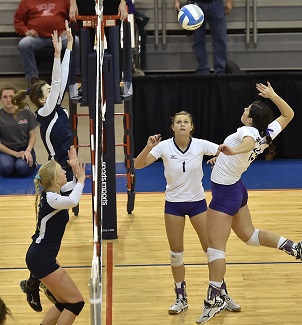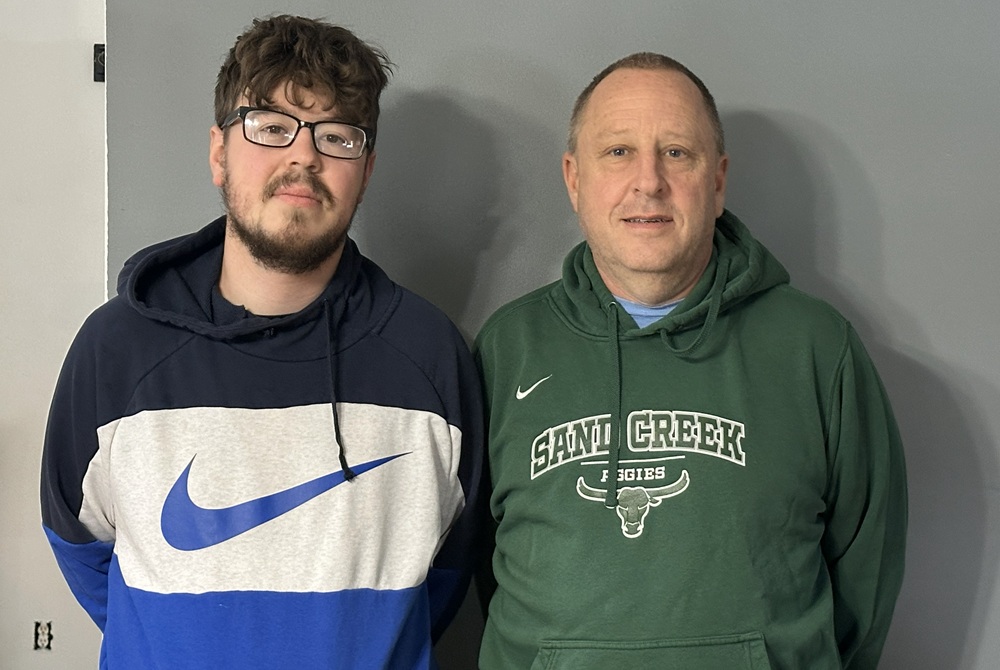
Task Force Building Multi-Sport Message
November 11, 2016
By Geoff Kimmerly
Second Half editor
Walled Lake Western’s Cody White draws his perspective on high school sports from a background that, while perhaps not unique, has to be close.
The Warriors senior is one of the top college football prospects in Michigan, a Big Ten-caliber player who has committed to continue his career at Michigan State University after he graduates in the spring.
Our state has a handful of athletes like that every year, of course. But White also is the son of former NFL player and Detroit Lions executive Sheldon White – and has followed his father’s Dayton, Ohio, footsteps in playing three sports during his high school career.
White plays football, basketball during the winter and baseball in the spring, in addition to travel basketball and baseball during the summer. He has played these same sports throughout high school. His freshman year he also competed in track & field, along with baseball. As of May – when White and his multi-sport experience were featured on Second Half – he hadn’t ruled out returning to track & field, in addition to baseball, as a senior.
“I couldn’t see myself not competing in those sports,” White said at the time. “I love them so much. I want to finish my senior year playing all three.”
It’s White’s experience, and the benefits enjoyed by so many who have shunned the recent trend toward specialization, that is driving the MHSAA’s Multi-Sport Task Force as it aims to promote the value of a varied sports experience through high school, even for athletes considered “elite” in a sport they’ll go on to play at higher levels.
The Multi-Sport Task Force met for the third time Oct. 27 and includes coaches, administrators and teachers with diverse experiences in athletics at schools large and small; urban, suburban and rural and in both the interscholastic and club settings.
The idea of moving away from specialization and back toward playing multiple sports has gained steam in recent years with pronouncements of how doing so paid off for nationally-recognized stars like professional golfer Jordan Spieth, baseball Hall of Famer John Smoltz and a number of members of the U.S. women’s soccer national team who played multiple sports through high school.
The MHSAA’s task force is working to develop that message, package it in the most digestible formats, and deliver it to the key decision-makers to benefit athletes at the age where the message can have the heaviest impact on their sports careers and growth into physically fit adults.
“This is a fundamental topic in school sports,” MHSAA Executive Director Jack Roberts told the task force during its most recent meeting. “This is something we’ll be talking about five and 10 years from now.”
The task force is charged with a series of goals that will be discussed below and are still in development. But there’s no doubt coaches will play a significant part in promoting and carrying out this important mission.
“Growing up was a little different (for me) than the usual kid. Going to Lions games and just being around football all the time. I think I love the game more because I was around it so much. But I think playing three sports helped me, too. The twisting of your hips in baseball, when you swing the bat, you’re using different muscles. And all the jumping you do in basketball. You have to move in tight spaces. With football, you’re with the football guys. By doing all three you meet different people.” – Cody White, “Western’s White Enjoys ‘Special’ Career” – May 4, 2016
What we’ve learned
The task force’s first meeting in April included discussions with Dr. Tony Moreno of Eastern Michigan University, a frequent Coaches Advancement Program instructor, and Dr. Brooke Lemmon of the MSU Sports Medicine Clinic. Among points from their focus on medical issues that result from specialization:
• Specialization has chronic, long-term affects; young people who do not learn physical literacy – how to solve movement problems – are less likely to be physically active and, hence, less likely to be physically fit. This is becoming an expensive health issue for society.
• The loss of physical education from schools is the root of these problems and has led to the creation of “privatized PE” for those who can afford a club sports experience. Physical education in schools, done correctly, can create a relatively noncompetitive environment that increases student interest in becoming physically active.
• More time spent in one activity will lead to more injuries, especially of the chronic nature. The number of hours per week a child spends on one sport activity shouldn’t exceed that child’s age (8 hours per week for an 8-year-old, for example).
Dr. Dan Gould, the director of the MSU Institute for the Study of Youth Sports, talked to the task force during its second meeting about how children perceive sports – and the need to adjust parents’ expectations for their kids’ success. He explained how kids can lose their identity focusing on just one sport, and also the importance of free play – the games kids make up themselves while playing in a structure-free environment.
Bob Mancini of USA Hockey visited with the task force most recently, explaining how his was the first governing body to tell athletes it wanted them to play their sport – but in order to do so well, play other sports also. USA Hockey’s American Development Model was launched in 2009 to in part promote multi-sport participation – and is growing hockey in the process, with increased participation seen at youth levels over the last three years.
“It’s just really fun to do different things. We don’t have a lot of the numbers, but we have the people who are willing to put in the hard work, even if it’s not their best sport. Each season is only three to four months at the most. So it keeps things exciting.”— 2016 Bronson graduate Kelsey Robinson, a defensive specialist in volleyball, former cross country runner, guard in basketball and a third baseman and centerfielder in softball, “Multi-Sport Experience ‘Special’ for Bronson” – February 2, 2016
Questions & Answers
The task force will meet again Feb. 8, and in the meantime there are a number of questions – and answers – to be considered.
The group has pinpointed a series of goals:
1. Partner with groups promoting diverse physical activity.
2. Encourage those promoting more and better physical education.
3. Prepare tools for administrators for use in interviewing prospective coaches, conducting meetings with their coaching staffs and encouraging them to “walk the talk” of balanced participation.
4. Assist in the explanation of the multi-sport experience to parents through a variety of media, including a guidebook and video explaining its benefits.
Carrying out these aspirations comes with plenty to discuss.
Who most needs to hear the message of multi-sport participation? It’s most likely junior high and middle school parents, or even those of elementary students just starting to experience organized athletics.
 What do these parents and children most need to know? Parents are stakeholders in their children’s athletic ventures. The challenge is convincing them our way is best for their kids’ futures, from a health and development standpoint.
What do these parents and children most need to know? Parents are stakeholders in their children’s athletic ventures. The challenge is convincing them our way is best for their kids’ futures, from a health and development standpoint.
Who should deliver this message? Celebrities obviously carry clout when they talk about how their multi-sport experiences led them to become successful adults. But there also could be a strong emotional tug from current student-athletes who tell their stories.
How can coaches and athletic directors help spread the word? The MHSAA, with input from the task force, will develop tools to help. But the options are many: could it come in video form, eye-catching graphics for use at coaches meetings, or live interaction at regional summits?
We are looking for ideas, both for getting out the message and incentivizing taking part in the multi-sport experience. Schools already are doing great things to promote multi-sport participation, and we’d love to hear about what's working.
To that vein, we’ll close with a final success story from this fall about a team that benefited from a lineup of multi-sport athletes:
Grosse Pointe Woods University Liggett on Oct. 15 ended an eight-year championship run by Ann Arbor Greenhills at Lower Peninsula Division 4 Boys Tennis Finals. Knights coach Matt Sobieralski relied on a roster filled with multi-sport athletes, including No. 1 singles player T.J. Dulac, who also ran cross country this fall.
Only one player on the Liggett roster plays only tennis, and Sobieralski says his players’ multi-sport participation served them well.
“It makes you tough, mentally tough and strong. And they’re competitive. That’s important. I think tennis, a lot of times, is 80 percent mental and 20 percent ability. You win a lot of matches with guts and just hanging in there. I always say a good player can win even when they’re not playing their best, because they’ll try something different and they keep fighting. That’s the team I’ve got. I’m really proud of their fight.” – Matt Sobieralski, “Liggett Ends Greenhills’ 8-Year Reign” – October 16, 2016
PHOTOS: (Top) Walled Lake Western's Cody White runs ahead of a group of Lowell defenders during last season's Division 2 Semifinals. (Middle) Bronson (right) goes for a kill during last season's Class C Semifinal against Traverse City St. Francis. (Top photo courtesy of Walled Lake Western athletic department.)

Father & Son Set to Meet for 1st Time Coaching from Opposing Benches
By
Doug Donnelly
Special for MHSAA.com
December 10, 2025
The bantering back and forth is almost complete.
 On Thursday, Mike and Zachary Zyla will finally coach against each other in a varsity girls basketball game.
On Thursday, Mike and Zachary Zyla will finally coach against each other in a varsity girls basketball game.
It’s a game that both coaches circled months ago when Zachary, 26, got his first head coaching job at Britton Deerfield.
“It’s going to be intense,” Zachary said. “I’m sure he will want to win just as badly as I will. Me and our girls have been talking about the game a lot because it’s a game we think we can win. We want to beat Sand Creek.”
Mike Zyla coaches Sand Creek and is Zachary’s dad. He is a longtime coach in cross country and track and added varsity basketball to his resume three years ago. Zachary, who played at Sand Creek, was hired this past offseason to coach the Patriots.
Both schools are in the Tri-County Conference.
“It’s going to be fun,” Mike said. “We’ve been going back and forth about it for a couple of weeks. We’ll see how it goes.”
Basketball is special in the Zyla household.
Zachary’s other brother, Ryan, coaches at a junior college in Minnesota. His sister, Chelsi, played two years of college basketball after graduating from Sand Creek. Their mom, Kirsten, keeps the scorebook for Mike’s games. She is a special education teacher at Britton Deerfield.
“When basketball season rolls around, that’s all we talk about,” Zachary said.
“I guess it’s a little bit in the bloodlines,” Mike said.
After graduating from Sand Creek in 2018, Zachary served in the Navy. He returned home two years ago and served two seasons as his dad’s assistant.
“I just love the game of basketball,” he said. “I’ve been playing since I was probably 2 years old. It’s the thing I’m passionate about. I watch almost every night. If it’s not a live basketball game, I watch clips of old games. I’m just a junkie for basketball.”
Mike said he misses having his son on his bench.
“I miss having him on staff,” Mike said. “He’s really sharp, picking stuff up on the fly. It was nice having him on the sidelines with me. It’s a good opportunity for him, though.”
Please welcome BD’s new varsity girls basketball coach Zach Zyla! Zach comes to BD from Sand Creek where his father Mike is the head girls coach. Zach assisted on the Aggie varsity girls team in the 2024/25 season and is a track assistant coach for the Aggies. Go Patriots! pic.twitter.com/6cpwUw6OW4
— BD Athletics (@athletics_bd) May 2, 2025
Zachary accepted the job in time to have a summer program with BD.
“I’ve always been a big fan of basketball,” he said. “It’s in my blood. I started coaching the Sand Creek hoopsters when I was 16 years old. I knew that’s what I wanted to do. I would say coaching at the varsity level was a goal of mine. It’s always been a dream of mine. I didn’t expect to get a head coaching job so soon. I’d like to get to the next level someday.”
He said he has a few new things for his team to run against his dad.
“He taught me a lot, but our coaching strategies are different,” Zachary said. “I think I’m going to have some things he hasn’t seen yet.”
Sand Creek and BD both lost their season openers Tuesday. Since BD’s game started at 4:30 p.m., Zachary was able to get to Sand Creek to see his dad’s game against Pittsford.
“He was able to scout us,” Mike said.
It’s all in good fun.
“We have a great relationship,” Zachary said. “We bounce ideas off each other all of the time. Even for our first game of the season, we were talking about what we should do, the offenses and defenses. We talk pretty much every day.”
As rare as it is for a father and son to coach against each other, it’s the second time it’s happened in Lenawee County in recent years. Hudson varsity boys basketball coach Jeff Webster coached against his son, Jamison Webster, when Hudson played Tecumseh two seasons ago.
Jamison said it was a great experience, one the Zylas will never forget.
“Coaching and competing against my dad’s teams at Hudson over the last few years has been a great experience,” he said. “We both want to win, being the competitors we are. That being said, the lifelong memories we have made being able to share a sport we both love is what makes it special.”
Zachary said he knows it will be a little different than normal.
“The game’s intensity will be higher than most nights,” he said.
Mike agreed. He doesn’t relish the idea of beating his son, but doesn’t plan on backing down. Since they are both in the TCC, they’ll face off again later this winter.
“We’re both pretty competitive,” he said. “Competitive genes are in the family. I don’t think either one of us will be very happy if we are on the losing side Thursday night.”
 Doug Donnelly has served as a news and sports reporter at the Adrian Daily Telegram and the Monroe News for 30 years, including 10 years as city editor in Monroe. He's written a book on high school basketball in Monroe County and compiles record books for various schools in southeast Michigan. He is now publisher and editor of The Blissfield Advance, a weekly newspaper. E-mail him at [email protected] with story ideas for Jackson, Washtenaw, Hillsdale, Lenawee and Monroe counties.
Doug Donnelly has served as a news and sports reporter at the Adrian Daily Telegram and the Monroe News for 30 years, including 10 years as city editor in Monroe. He's written a book on high school basketball in Monroe County and compiles record books for various schools in southeast Michigan. He is now publisher and editor of The Blissfield Advance, a weekly newspaper. E-mail him at [email protected] with story ideas for Jackson, Washtenaw, Hillsdale, Lenawee and Monroe counties.
PHOTO Britton Deerfield varsity girls basketball coach Zachary Zyla poses for a photo with his father Mike Zyla, right, the varsity girls basketball coach at Sand Creek. (Photo provided by the Zyla family.)

